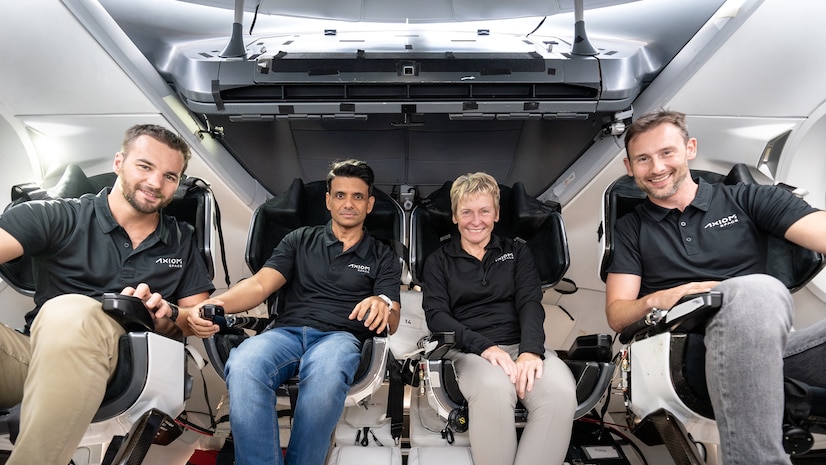
In today’s best update, SpaceX has officially called off the launch of the Falcon 9 carrying the Axiom 4 mission, which was scheduled to take Indian Air Force officer and pilot Group Captain Subhanshu Shukla to the ISS on July 11, 2025, after discovering a liquid oxygen (LOx) leak during pre-launch testing. While this is the second delay – first due to weather, now due to a technical issue – it reflects the uncompromising value placed on safety in today’s era of private human spaceflight. Stay tuned for all the updates here.
All the points in this post
Mission at a Glance: What Is Axiom‑4?
Axiom 4, also known as Ax4, was launched by Axiom Space aboard SpaceX’s Falcon 9 rocket with the Crew Dragon spacecraft. The four-member crew includes Commanding Astronaut Peggy Whitson (USA), a veteran NASA employee, Pilot Group (India) Captain Sławs Użananski-Wiński (Poland), and Mission Specialist Tibor Kapu, from Hungary. With all four crew members from countries other than the United States, this is a significant milestone in international space cooperation and a sign of the expanding scope of the commercial astronaut program.
Sławs will be the second Indian to visit the ISS and the first to do so on a commercial mission. The first Indian in space was Rakesh Sharma in 1984, aboard a Soviet spacecraft. Shukla’s mission, supported by ISRO, in close collaboration with DBT and NASA, includes experiments on microgravity agriculture, such as growing fenugreek and pulses – for future long-term missions.
Timeline of Launch Attempts & Delays
Ax-4 was originally scheduled to launch from Kennedy Space Center Pad 39A (LC-39A) on June 10, 2025. It would have marked India’s triumphant return to space after more than four decades.
First Weather Delay: To June 11
On June 9, SpaceX announced a one-day delay due to adverse weather conditions at Cape Canaveral, moving the launch to 5:30 PM IST (8:00 AM) on June 11. A detailed “L‑8‑hour” weather briefing – the final go/no-go check – was scheduled by the Space Force’s 45th Weather Squadron to guide the decision.
Why Was Launch Called Off?
Cape Canaveral may be iconic, but it’s also notorious for its moody coastal weather. Launch conditions can be affected by crosswinds, upper-level wind shear, and thunderstorms. For the Axiom-4 mission, weather was already a concern, with meteorologists from the 45th Weather Squadron warning of unstable conditions due to tropical moisture across the Atlantic. While Falcon 9 rockets are built to withstand severe weather, the risk of lightning strikes and low cloud cover can violate NASA’s launch commit criteria. It’s something that both NASA and SpaceX are strictly compliant with.
Weather doesn’t just delay launches—it delays the entire pre-launch chain, from rocket rollout to fueling and static fire testing. As the skies over Cape Canaveral turned hostile, every small step became uncertain.
Liquid-Oxygen Leak After Static Test
As the weather window began to improve, more serious problems arose. During the final pre-launch test after the static fire test, SpaceX engineers discovered a leak in the liquid oxygen (LOx) system, a routine but unavoidable fire when the rocket’s engines are stationary. LOx is used as an oxidizer in the Falcon 9’s Marlin engine. According to initial reports, the leak was discovered in the Falcon 9’s second stage, likely near the coupling area that connects to the Dragon spacecraft. This is not just a patch-and-go situation.
SpaceX takes no chances when humans are involved. The leak prompted a full-scale review, which forced SpaceX to remove parts of the rocket for inspection and repair. This means rebooking launch windows and requesting additional security clearances from NASA and the FAA.
Insights From SpaceX & ISRO Teams
The level of cooperation between the American and Indian teams makes the delay even more interesting. In addition to SpaceX’s Falcon Operations team, the telemetry data is reportedly being reviewed by ISRO engineers, who are closely monitoring every aspect of the mission. Since Shubhshan Shukla’s mission includes Indian-designed biological payloads and sensor hardware, Indian agencies like the Department of Biotechnology (DBT) and DRDO are also closely monitoring developments. The delay, while disappointing, is seen as a necessary and responsible step. As one SpaceX official put it, “It’s better to be a few days late than to compromise safety by a millisecond.”

Technical Deep Dive: Understanding LOx Leaks
Liquid oxygen, commonly known as LOx, is a supercooled version of oxygen that serves as the oxidizer for the Falcon 9’s RP-1 (kerosene) fuel. The rocket’s engines are powered by this combination, which enables lift. LOx is kept at temperatures below 183°C, making it extremely dense and reactive, especially when launched at high pressure. Many launch vehicles use LOx, but because of its instability. A leak doesn’t just risk reducing thrust – it can also cause a fire hazard, pressure imbalance, or catastrophic failure during stage separation.
Decision-Making: Standing Down a Mission
A mission like Ax4 cannot be left to the coordination of NASA, SpaceX, Axiom, and ISRO. This includes collaboration between SpaceX, the launch provider; Axiom Space, the mission customer; NASA, the ISS’s host agency; and, in this case, ISRO, Shukla’s sponsoring agency. Axiom ensures that mission protocols are consistent with crew training and objectives, while SpaceX typically takes the lead on technical evaluations. In this situation, all four parties have come to the same conclusion: not to move forward until the issue is fully resolved and verified.
Safety vs Schedule – How Risks Are Weighed
The unspoken rule for human spaceflight is “better late than dead.” For crew members like Subhanshu, who have trained for years, delays are costly and mentally exhausting. However, the schedule must always take priority over safety. And in this case, with the weather instability and LOx issues, the risks were too high to go ahead. Engineers and safety officials would rather suffer the consequences of a hasty launch than a hundred delays.
Implications of the Delay
For Shubhanshu Shukla, Group Captain Shubhanshu Shukla, the delay is undoubtedly an emotional and mental rollercoaster. Preparing for a space mission is not just about physical fitness – it’s about years of intense mental conditioning, simulation training and mental preparation. Trained not only in India but also at NASA and Axiom facilities, Shukla has spent months simulating ISS docking, emergency return scenarios and payload operations. He also carries a sense of national pride as millions of people follow him as India’s new space ambassador. Despite the pressure, Shukla has responded graciously. In his latest statement, he said, “Space doesn’t wait for emotions, it waits for preparation. We are waiting for a safe window.
For ISRO, India’s Space Diplomacy
This mission is not just personal – it is geopolitical. ISRO’s participation in Axiom-4 reflects India’s commitment to global space cooperation. India’s readiness to play a key role in international human spaceflight is demonstrated through partnerships with non-governmental organisations like Axiom and space agencies like NASA. ISRO has stood by SpaceX’s technical assessment and has further strengthened its confidence in the mission. The rescheduling doesn’t just affect Axiom-4 – it also spills over into the station crew schedule, cargo manifests and scientific research time slots.
What Comes Next – Fixes & New Launch Window
Repairs, once the LOx leak is detected, the clock resets. To fix the problem, SpaceX’s Falcon 9 will undergo component replacement, seal integrity testing, and a second static fire. If a leak is detected at a critical weld or valve junction, the entire second stage may need to be replaced. This is not a quick task. Engineers work in clean-room conditions. The verification process can take anywhere from 3 to 10 days, depending on parts availability and test results. SpaceX has a stockpile of backup stages and parts, which can speed up preparation if everything goes smoothly. After internal teams sign off, a NASA/FAA cross-agency launch readiness review will follow.
Notification Processes & Range Availability
Airspace must be allocated and sea areas cleared. This coordination includes the Space Force, the FAA, and NASA. In addition, The availability of the ISS is limited. Known as “phasing windows,” there are specific orbital conditions under which the Crew Dragon must dock with the ISS. These only occur every few days and must happen at the right time. The launch postponement also affects other scheduled launches, including the Starlink satellites and other NASA missions. So even if repairs are completed quickly, the scheduling conflict could delay the next attempt beyond mid-June.
The Bigger Picture: Private Human Spaceflight & Reliability
Falcon 9 Crew Operations A Frequency vs. Safety One of SpaceX’s biggest successes has been normalizing the frequency of human spaceflight. The Falcon 9 and Crew Dragon are now among the most widely used vehicles in orbit, as they have completed countless missions for NASA, private companies, and Axiom. Unnecessary inspections and multiple safety nets are crucial. It’s impossible to overstate the difficulty of launching humans, and any oversight can lead to death. To catch problems early, engineers can even introduce new diagnostic sensors and predictive failure analysis, according to Gacha.
How Axiom‑4 Fits in Long‑Term Goals
Axiom’s vision isn’t just about sending astronauts aboard the spacecraft – it’s about building the first commercial space station by 2031. Each mission, like AX-4, serves as a rehearsal, testing crew operations, docking mechanisms, life support systems, and the commercial training pipeline. AX-4 is also important for astronauts outside the United States, proving that space is no longer just for superpowers. With passengers from India, Hungary, and Poland, the mission sets the tone for future space diplomacy and commercial partnerships. The delay is a setback.
Public & Media Reaction
On social media platforms like Twitter, Instagram, and Reddit, the delay in the Axiom 4 launch quickly became a topic of discussion. Hashtags like #Ax4Delay, #ShubhanshuShukla, and #Falcon9StandDown were filled with both disappointment and understanding. Space travel fans in India and around the world expressed their support for the crew. “Safety before sight. Can’t wait to see you launch soon, @ShubhanshuSpace!”. “Rockets need a little self-care too. Go SpaceX. Go Ax-4!” .
YouTube creators, space influencers, and journalists streamed live streams and breakdown videos to explain the significance of the LOx leak and the cautious mission protocols. This transparency was welcomed by enthusiasts as a positive sign for the burgeoning private space industry.
Official Statements from SpaceX, ISRO
SpaceX quickly issued an official update stating, “Following a routine static fire test of Falcon 9 prior to Axiom Mission 4, engineers discovered a minor leak in the second-stage LOx system. The crew is safe and ready for the mission.” In addition, ISRO issued a public statement: “We agree with SpaceX and NASA’s decision to prioritize the safety of the crew. Group Captain Subhanshu Shukla is in good health and high spirits.
Lessons Learned – What This Means for Future Missions
Pre-launch rigor, this delay is an incredible setback to launching humans into space The complexity is highlighted. Every component – from the pressure valve to the environmental seal – has to work perfectly. Even for missions that seem “routine” at this point, it demonstrates the need for pre-launch testing. This problem shows that in space engineering, constant vigilance never goes out of style. Although it seemed insignificant on paper, the LOx leak could have had serious consequences during flight. However, due to strict oversight, it was discovered in time. As a result, even stricter standards are expected for future crewed missions.
Coordinated International Standards
From NASA’s oversight to ISRO’s payload management, Axiom’s training and supply – Ax-4 is a symphony of global collaboration. Future missions will benefit from this model, with more countries bringing their astronauts and payloads aboard commercially operated spacecraft. Finally, one less clear issue is how commercial players and space agencies deal with public expectations. With social media and a 24/7 news cycle, launches are not just technical events – they are global showcases.
The delay of Axiom-4 shows the world that security doesn’t have to be a nightmare – when you inform and reassure people, they come running to you.
Final Thoughts & Outlook
It also represents India’s return to human spaceflight and the development of the commercial space age. But that’s what makes it worth following. Every challenge, every solution, and every delay brings us closer to a more robust and reliable system. Group Captain Subhanshu Shukla’s journey to the stars has only been briefly halted. Falcon 9 will not only carry astronauts and cargo, but it will also carry the collective hopes of millions of people from Earth. Not to failure, but to a safer, smarter, and more connected space future.
THE END
The delay of the Axiom-4 mission is disappointing, but it also demonstrates the challenges of space travel. SpaceX’s cautious approach ensures that astronauts like Shubhash Shukla can reach space safely, regardless of technical difficulties or adverse weather conditions. As we wait for the next launch, one thing is clear: the future of space exploration is bright, but patience is key. Stay tuned for more updates on this groundbreaking mission. Stay well, stay healthy, and see you tomorrow for more news.






